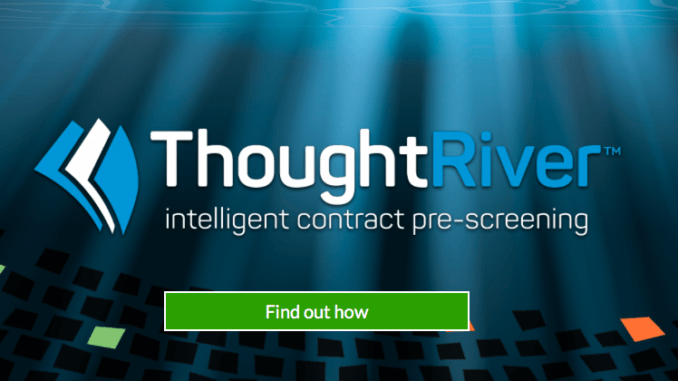
Last week Artificial Lawyer shared the news that AI company, ThoughtRiver, which has a focus on risk analysis and pre-screening of legal documents, had been awarded funding for a major new project to develop what is being labelled as ‘thinking AI’.
Naturally curious of such a project (see the details of the funding in previous story here), AL had a chat with Tim Pullan, Founder and CEO of ThoughtRiver, along with two of the engineers involved in the project: Dom Hudson, Lead Intelligence Architect, and Nathan McCoy, Data Scientist.
The project will also be supported by NLP consultancy iLexIR and its founder, Professor Ted Briscoe of Cambridge University. The two groups will share £400,000 of Innovate UK funding.
So, first of all, in broad terms, what will be the new capabilities of this legal AI application?
Pullan and team sum it up this way: today most doc review systems are ‘bottom up’, i.e. the reviewer uses an NLP analysis and extraction system to yank out a range of bits and bobs of information that might be useful. They then have to go back and consider what they’ve found and decide what it all means.
The ‘thinking AI’ project, codename ‘DBA’, will seek to operate from the other end of the spectrum, i.e. with a ‘top down’ approach.
Pullan explains: ‘If you think about the problem we’re solving, it’s about helping clients get information ever more quickly from contracts so they can make decisions.’
‘We are doing this with pre-screening. We ask 1,000s of questions about a contract to help save time,’ he adds.
Or, to put it another way: rather than a lawyer sifting through all the extracted data, the system goes straight to asking all the questions one would expect a lawyer to ask of such a contract and presents the answers to you from the beginning.
The idea is – very roughly – that you pop a document into the system, it figures out what it is, knows what things you’re likely to want to know about it, finds the answers to these questions and then presents you with a selection of these responses.
One could call it a sort of ‘legal AI FAQ‘ system for contracts.

Pullan and team explain that this is necessary as clients don’t want to spend ages figuring out what all the bits of data mean that they’ve extracted, they just want the answers to questions they’re likely to want to ask. Which makes sense.
After all, when it comes to other areas of search tech, that is what we want: the answer. If you use Google, you want – what appears to be – the best answer to your question. You don’t want bits of info randomly thrown at you which you then have to wade through and triage by yourself. I.e. Google may provide you with 10 million pages of links for each query, but we only ever look at the first three on the first page. We just hope those are the best responses.
The team sums this up another way: ‘We want to ask bigger questions, which means less questions.’
This they say puts more burden on the computational system and that this is ‘not easy‘, to use some classic British understatement.
It’s tricky because it will involve operating at what McCoy calls ‘a deeper level of semantic meaning’.
And, although it may sound simple to ask: can I sign this document? There is a huge amount of variables and complex lines of logic behind coming to any reliable answer, especially via an automated system.
But, AL can see that this has got to be the way to go for all review systems. One could call it also the ‘cut to the chase legal AI’, because, why is anyone doing review? They are looking for landmines and they are looking for permission to move ahead to the next stage of the legal process and so on.
If we can skip to the end of the process, then why not? To use a culinary analogy: do you want a sandwich, or do you want all the ingredients of a sandwich placed on a table? Of course, most people will want the made sandwich.
AL then asks if this will involve a bot, or voice-activated Q&A? The team says that’s not really central to the project yet, but several types of interface are possible.
And there we have to leave it, as the team cannot go much further into the details other than to say ‘we have a new algorithmic process’ which they don’t want to explain in detail – yet.
All they can add is that the project will run for a year to start with and that documents in the English language will be the main focus for now.
Good luck to them. AL was just starting to think that the pace of AI innovation could do with a new injection, and here it is. A great way to round off 2018!
2 Trackbacks / Pingbacks
Comments are closed.